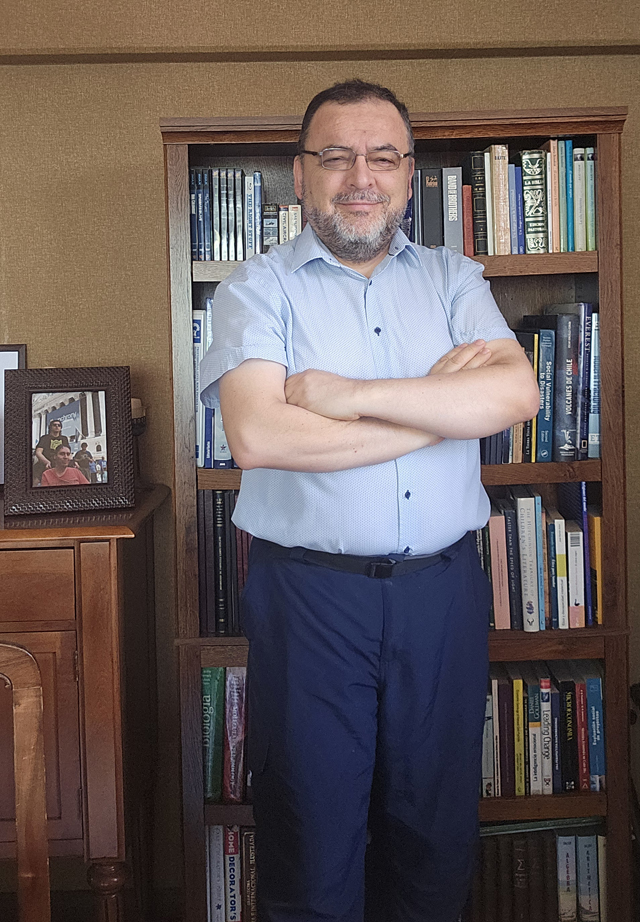12 March 2024–Earthquakes were part of Luis Donoso Carmona’s environment “for as long as I can remember,” growing up in northern Chile in the small city of Vallenar in the Atacama Desert, he said. His great-grandmother told stories of the destroyed ports and railway lines and overturned locomotives she had seen after the Great Atacama Earthquake (magnitude 8.6) in 1922.
“With that environment, it didn’t take me much to decide to try to understand what this giant was that shook houses and destroyed cities when it woke up,” Donoso said.
 He studied geophysics at university, aiding seismologists who came from all over the world to collect data on the magnitude 8.0 Algarrobo earthquake that struck Santiago, Chile in 1985. At the end of his studies, he decided on a career in exploration geophysics and has been working with Chile’s Empresa Nacional del Petróleo, or ENAP, for 35 years.
He studied geophysics at university, aiding seismologists who came from all over the world to collect data on the magnitude 8.0 Algarrobo earthquake that struck Santiago, Chile in 1985. At the end of his studies, he decided on a career in exploration geophysics and has been working with Chile’s Empresa Nacional del Petróleo, or ENAP, for 35 years.
Learning about seismic acquisition taught him to appreciate the effort behind placing geophones in frozen ground and identifying sources of noise from wind to animals eating grass nearby. “All of this opened the doors to a new universe regarding how to do seismology in a different and unthinkable way,” he said.
“I also got to see the transition between the end of analog interpretation, where all processes were on paper, and the first workstations,” Donoso recalled. “In addition to learning and understanding what these seismic process centers delivered, they were delicate and noisy creatures that had to be kept as cold as possible.”
Then came UNIX, “and the heat dissipated by those mega screens was equivalent to small ovens that housed large spaces,” he added. “It was like interpreting while looking through the glass of a dishwasher to say that it had the dish that was being washed.”
Despite numerous computational and technical innovations, Donoso noted, seismic research still depends on “the physics and the processes of what generated that information, its limitations when acquiring it, the elastic properties of rocks, the properties of elastic waves. That is—welcome back to seismology!”
Some of Donoso’s favorite projects through the years include working on a geothermal project at an altitude of 4500 meters and participating in the design and interpretation of multiple 3D seismic campaigns. He has also provided geophysical and technical support to several institutions and private investors over the years, including for a project to improve navigation security in fjords and in developing an earthquake early warning model for industrial systems.
As an advisor to the Chilean government, one of the larger projects he worked on was the initial stages of characterizing the continental shelf off Chile. “Once again, training in seismology was extremely valuable to appreciate the processes and phenomena that occur in the oceanic crust, to visualize the accretion prism in a subduction zone in a clear and evident way,” he said. “Seeing that for the first time is a privilege and a satisfaction to contribute to the document that was finally deposited with the United Nations.”
One of the future projects Donoso hopes to participate in is developing an exploration protocol for white hydrogen deposits, natural hydrogen that some believe could be a significant source of clean energy. A successful protocol would “push to the limit both everything known in geosciences and the currently available technologies. That is an ocean not yet navigated,” he said.
Donoso is also a professor of applied geophysics at Universidad del Desarrollo, where he shares with his students his wealth of real-life examples of how research can impact industry. He also has a master’s degree in political science, security and defense, a diploma in business management, and was technical advisor pro-bono in the Chilean Senate from 2006 to 2013 in civil protection and renewable energy policy. In recent years he has been frequently interviewed by the news media in Chile regarding issues of geosciences, earthquakes and civil protection.
One thing that he would like everyone to know about seismology is that the discipline goes far beyond earthquakes and is vital for “mining and oil and gas exploration, environmental studies, civil protection, the construction industry, fishing industry, medicine, security and defense industry, to mention the main ones,” Donoso said.
“This implies an enormous challenge, and that is to be able to explain it simply to specialists from other scientific disciplines, who do not master the techniques or concepts that are elementary for a seismologist or geophysicist,” he added. “Since the vast majority do not understand the use value of what they have at their disposal, it is always necessary to explain in a clear and simple way what is being done or what one aims to achieve.”
SSA At Work is a monthly column that follows the careers of SSA members. For the full list of issues, head to our At Work page.
